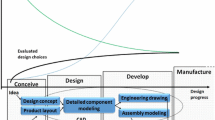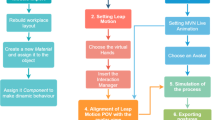Abstract
Design is one of the most important stages in the manufacturing cycle and influences all the subsequent stages of product development. In the context of today’s iterative design methodology, the modification of any design is a process involving many evaluations and improvements to the solutions chosen in earlier stages. For this purpose, in the most recent decade, 3D computer simulations have become common tools used within industry. Whilst virtual reality (VR) technology is seen as the interaction technology of the future, much of the current research in this area is carried out to explore the potential benefits and added value brought by the integration of this into standard software technologies currently used at various stages in manufacturing life cycle. A lot of attention has been given to exploring the usability and benefits of interactive VR for assembly planning, knowledge elicitation and design and simulation. However, little research has focussed on the analytical aspects of the design process, for example in the use of VR as an interface for simulation software in finite element methods and multi-body systems. This paper introduces research focussing on applications of virtual environments (VEs) for interactive design evaluation and modification adapted and used with standard simulation software. The use of such interactive visualisation offers the engineer more realistic real-time representations of the design and advanced facilities to interact with the model during the design process. While design evaluation is based mainly on visualisation; design modification requires interactive changes of the model during the simulation, and the interfaces described here highlights such applications. In this work, two software prototypes have been developed using VR technology. First, a software tool called design evaluation in virtual environments is presented together with an application in civil engineering to illustrate the mode of operation and added value of the use of an interactive visualisation environment. Linking the simulation software with the VE provides real time bi-directional communication of graphical information which can be successfully achieved even within the limits of current computer technology. The tool includes a suite of software modules and a user interface to facilitate the link between the simulation results and the VE. The second tool facilitates the design modification in virtual environments system by providing real time dynamic simulation. Two dynamic approaches are investigated in order to study the real time simulation issues in the context of design modification and system performance: the classic approach based on rigid interconnected bodies, and a new and novel approach developed by the authors based on particles dynamics. Both implementations have been tested and compared on a mechanism application under the same computing conditions. The research applications presented demonstrate the practicality, flexibility and versatility of the visualisation in virtual environment in design evaluation and modification. However, the computer efficiency whilst carrying out real time dynamic simulation is limiting the range of applications to models of moderate size; however, this is an improvement on previous similar applications.













Similar content being viewed by others
References
Antonya CS (2004) Graphical simulation of rigid body systems (in Romanian), Transilvania University Press
Antonya CS, Talaba D (2004) Dynamic simulation of civil engineering structures in virtual reality environment. In: MBD-MST 2004, 3rd international symposium on multi-body dynamics: monitoring and simulation techniques, Loughborough. Professional Engineering Publishing, pp 137–145
Cuadrado J, Gonzalez M, Gutierrez R, Naya MA (2004) Real time MBS formulations: towards virtual engineering. In: Product engineering, eco-design technologies and green energies. Springer, Heidelberg, pp 253–272
Eberhard P, Li Z (2006) Virtual reality simulation of multibody systems. In: Proceedings of EUROMECH colloquium 476, Ferrol
Grant H, Lai CK (1998) Simulation modelling with artificial reality technology (SMART): an integration of virtual reality and simulation modelling. In: Proceedings of the 1998 winter simulation conference, pp 437–441
Haugh EJ (1989) Computer aided kinematics and dynamics of mechanical systems. In: Vol. I: basic methods. Allyn and Bacon
Hibbeler RC (2001) Engineering mechanics: dynamics, Prentice Hall, Englewood Cliffs
Kirner TG, Kirner C (2005) Simulation of real-time systems: an object-oriented approach supported by a virtual reality-based tool. In: Proceedings of the 38th annual simulation symposium (ANSS’05)
Lin ST, Huang JN (2002) Stabilization of Baumgarte’s method using the Runge–Kutta approach. J Mech Des 124:633–641
Mengoni M, Germani M (2006) Integration of virtual reality technologies in industrial design processes: a structured approach. In: Proceedings of virtual concept 2006, Playa Del Carmen, Mexico
Modern PJ, Stedmon AW, D’Cruz M, Sharples GJ (2003) The factory of the future? The integration of virtual reality for advanced industrial applications. In: HCI International 2003. Proceedings of the 10th international conference on human–computer interaction, Crete. Lawrence Erlbaum Associates, Hillsdale, June 22–27 2003
Rehn GD, Lemessi M, Vance JM, Dorozhkin DV (2004) Integrating operations simulation results with an immersive virtual reality environment. In: Proceedings of the 2004 winter simulation conference, pp 1713–1719
Ritchie J, Simmons J, Holt P, Russell G (2002) Immersive virtual reality as an interactive tool for cable harness design. In: Proceedings of PRASIC 2002—product design, University of Transilvania, Brasov, Romania, vol 3, pp 249–255
Sanchez-Segura MI, Cuadrado JJ, Moreno AM, De Amescua A, De Antonio A, Marban O (2004) Virtual reality systems estimation vs. traditional systems estimation J Syst Softw 72:187–194
Talaba D, Antonya CS (2004) Dynamic models in multi-body systems: a product life cycle key technology. In: Product engineering, eco-design technologies and green energies. Springer, Heidelberg, pp 227–252
Author information
Authors and Affiliations
Corresponding author
Rights and permissions
About this article
Cite this article
Antonya, C., Talaba, D. Design evaluation and modification of mechanical systems in virtual environments. Virtual Reality 11, 275–285 (2007). https://doi.org/10.1007/s10055-007-0074-6
Received:
Accepted:
Published:
Issue Date:
DOI: https://doi.org/10.1007/s10055-007-0074-6




